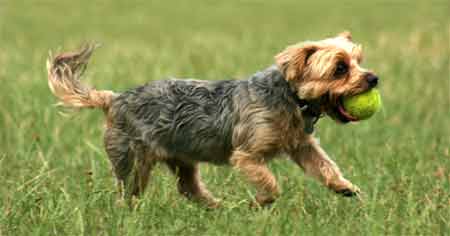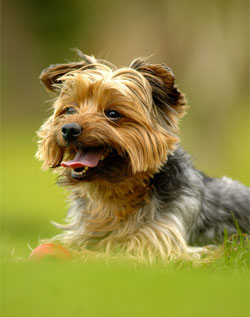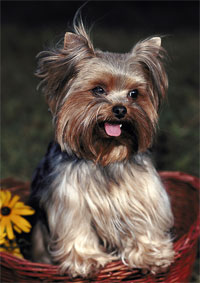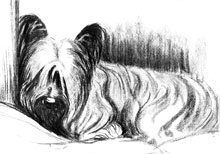|

Strong and Compact: The Yorkie has a compact, small build. It holds itself in an upright, sprightly manner which makes it look confident and self-assured (a reflection of its temperament). At its best, the appearance should be one of spirit, cleverness, curiosity, and vigor.

Color coordinated: The Yorkie should have a long, steel blue and tan coat that hangs straight and parts down the middle. However, many Yorkies do not conform directly to the standard. Some coats are black or silvery gray on the body. Tan is on the face and legs. The hair is usually straight and will grow long. Yorkies can also have somewhat wavy hair, although it is not acceptable for show dogs. In either case, Yorkie hair is soft, silky, fine, and high-maintenance, and must either be trimmed short or washed and brushed frequently. Show dogs often have their hair 'wrapped' in rice paper, after a light oiling. This prevents the hairs from being broken easily, and keeps the coat in condition. The nose, paw-pads, lips, and eye-rims must be darkly pigmented.

A little feisty: The Yorkshire Terrier, though a toy breed, still retains much of its Terrier ancestry in terms of personality. Though personalities differ from dog to dog, they are generally intelligent, independent and spunky. Yorkies, especially males, are very territorial and are known for their disregard for the limitations of their own size. They will often attack much larger dogs despite their extreme size disadvantage.
Rat-killers: Yorkies typically get along well with cats and other dogs, and love to play together in groups. However, they are terriers, and even an old, sedentary lap dog may eagerly hunt rodents. Because they are so small, they are easily injured; They usually get along well with children, but may be endangered if kept in the house with an  undiscerning or abusive person, especially a child. Also, despite their small size, if attacked or continually provoked, like all dogs, they pack a surprisingly powerful bite. undiscerning or abusive person, especially a child. Also, despite their small size, if attacked or continually provoked, like all dogs, they pack a surprisingly powerful bite.
Yorkshire Terriers tend to be more difficult to train than some of their canine cousins; however, this difficulty is considered to be a result of the breed’s characteristic prey drive rather than any major deficiency of intelligence as they were bred to work without human intervention.
Imperfections: Yorkies tend to develop cataracts in their old age, but their small size limits the effects of conditions such as arthritis. There is also the possibility of tracheal collapse, the cause of which is thought by many to be partially genetic, and partially caused by environment- specifically, the strain an energetic Yorkie puts on its neck when straining against its collar. Most veterinarians recommend use of a harness instead of a collar to help prevent the chronic coughing caused by partial trachea collapse. As with many purebred dogs, the Yorkshire Terrier is prone to certain genetic disorders. Most common is the liver shunt (portosystemic shunt). In this condition some of the dog's blood bypasses the liver and as such does not get cleaned of those toxins that the liver is responsible for removing. A Yorkie with this condition might exhibit some or all of the following symptoms: small stature, poor muscle development, behavioral abnormalities, unresponsiveness, seizures, and so on; however, if treated by a veterinarian, the condition is most often reversible in time.

 Of uncertain descent: Most believe that the Yorkshire Terrier is the product of commingling Scottish and English terriers when many Scots were displaced by the Industrial Revolution and settled in England. Though pedigrees are not available for the first Yorkshire Terrier ancestors, several breeds have been suggested, including the Old English Black and Tan, which is also considered the ancestor for the Welsh Terrier and the Manchester Terrier, the Waterside Terrier, the Clydesdale Terrier, and the Paisley Terrier. The Scottish influence, brought in by the weavers during the industrial revolution, are the same ancestors as the Scottish Terrier, West Highland White Terrier, and Cairn Terrier (all once one breed), as well as the Skye Terrier. Many have suggested that at some time the Maltese, an old breed from Malta, may be in the background of some as well. The original Yorkshire Terrier, known as the "Broken-Haired Scotch Terrier" was a 12-to-14 pound dog with wire hair whose intended purpose was the catching of rats and other vermin that lived in small spaces. Of uncertain descent: Most believe that the Yorkshire Terrier is the product of commingling Scottish and English terriers when many Scots were displaced by the Industrial Revolution and settled in England. Though pedigrees are not available for the first Yorkshire Terrier ancestors, several breeds have been suggested, including the Old English Black and Tan, which is also considered the ancestor for the Welsh Terrier and the Manchester Terrier, the Waterside Terrier, the Clydesdale Terrier, and the Paisley Terrier. The Scottish influence, brought in by the weavers during the industrial revolution, are the same ancestors as the Scottish Terrier, West Highland White Terrier, and Cairn Terrier (all once one breed), as well as the Skye Terrier. Many have suggested that at some time the Maltese, an old breed from Malta, may be in the background of some as well. The original Yorkshire Terrier, known as the "Broken-Haired Scotch Terrier" was a 12-to-14 pound dog with wire hair whose intended purpose was the catching of rats and other vermin that lived in small spaces.
The Adam of yorkies: In 1870, the breed was renamed the Yorkshire Terrier, after the county of Yorkshire, England where the breed is believed to have originated. The father of the breed is considered to be Huddersfield Ben, who was born in 1865 and died in 1871 from a carriage accident, the inbred offspring of a mother and son. Huddersfield Ben was bred by Mr. W. Eastwood Huddersfield. A multiple champion, Huddersfield Ben set the foundation for what would develop into the modern Yorkie.
 Rising Star: Based on registrations, Yorkshire Terriers became the #3 most popular dog breed in the United States in 2005 according to the American Kennel Club, trailing only the Labrador Retriever and the Golden Retriever. Rising Star: Based on registrations, Yorkshire Terriers became the #3 most popular dog breed in the United States in 2005 according to the American Kennel Club, trailing only the Labrador Retriever and the Golden Retriever.
A newly proposed breed, the Biewer, is a developing new breed based on the Yorkshire Terrier, built on an F1 cross to a Yorkshire Terrier. It has been noted that the opinion of many breeders is that as the Biewer breed develops, it should no longer be bred (known as backcrossing) with the Yorkshire Terrier.
-----------------------------------------------------------------------------------------------------------------------------
Famous Yorkies
War Hero: Smoky was a Yorkshire Terrier who belonged to William Wynne of Ohio. Mr. Wynne adopted Smoky while serving with the 5th Air Force in the Pacific Theatre. Mr. Wynne trained Smoky to perform various tricks to entertain himself and his comrades. Smoky was later entered in Yank Magazine’s Best Mascot Contest. She won first prize and had her picture on the cover.
Smoky became a war dog when she used her small size to her advantage and helped to “run” communication wire through a culvert that was under a runway. Without Smoky’s assistance, the runway would need to be excavated while the cable was laid. The runway would have been inoperable for several days. Smoky was deemed the most famous dog of World War Two. She returned home to Ohio with Mr. Wynne where she continued her “entertainment” career.
Movie Star: Most recognize Toto (from The Wizard of Oz) as a Cairn Terrier from the 1939 film version, and Baum's book did not specifically state Toto's breed. However, from the illustrations in the first book many have concluded that Toto is a Yorkshire Terrier, as this breed was very popular at the time. It should be noted that Toto was a Boston Terrier in later books of the Oz series.
All text is available under the terms
of the GNU Free Documentation License
|
